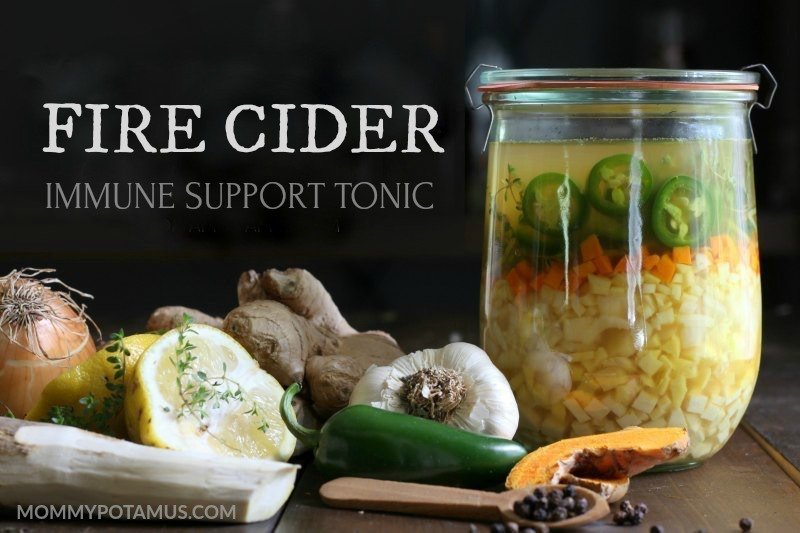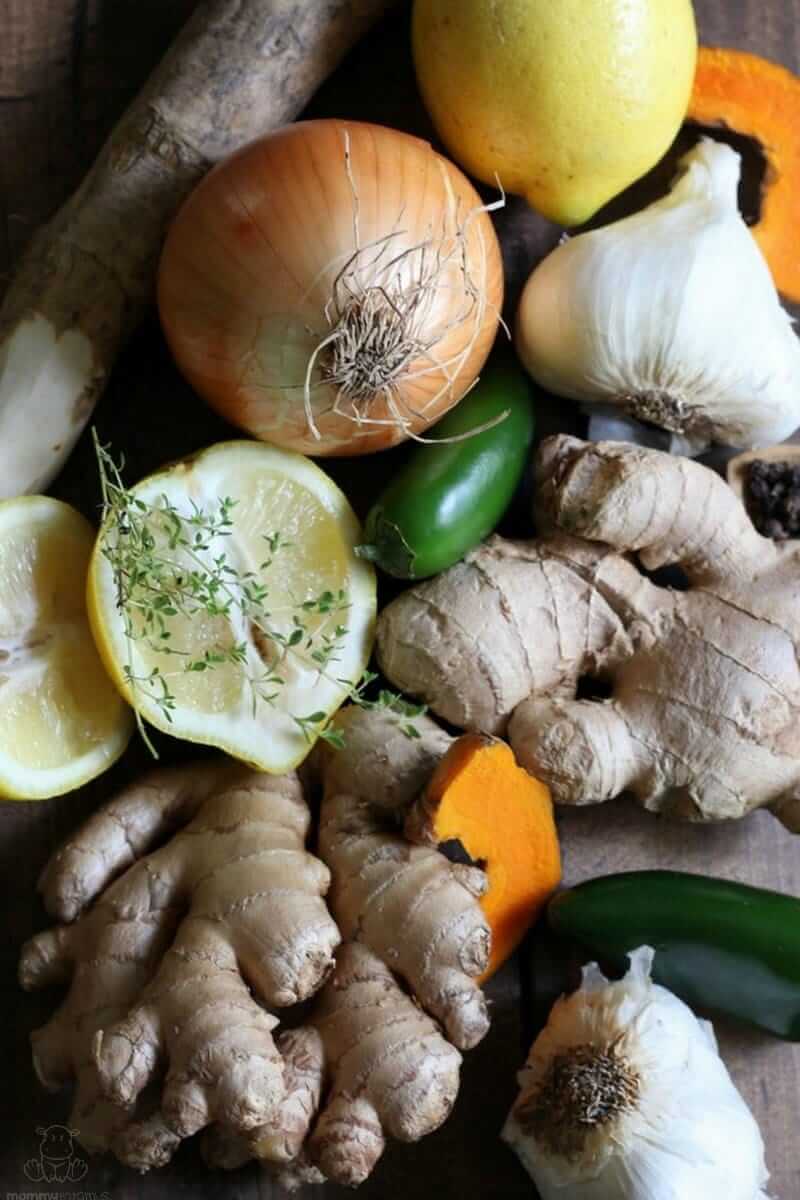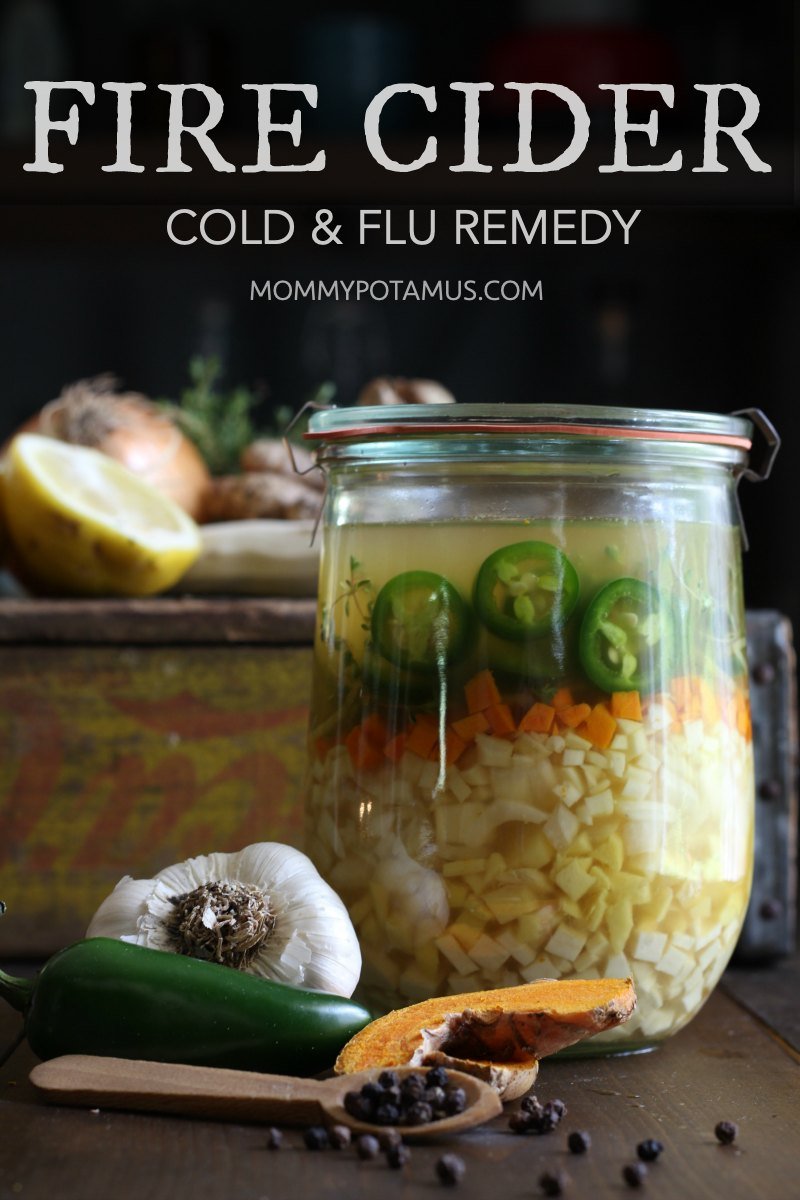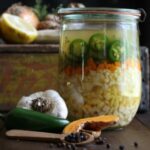
It’s no secret that I believe in fairy tales, but they’re mostly of the modern day sort. Occasionally, though, I come across a recipe or ingredient that seems like it was pulled directly from one of Grimm’s stories. That’s totally how I feel about keeping unicorn root in the cupboard, and this fire cider recipe in the fridge.
Though not imparted with any actual mystical powers, fire cider truly is magical in its own right. Like elderberry syrup, this tonic is revered by herbalists for its ability to support the immune system during cold and flu season, allergy season, or any time the immune system needs support.
So, what is fire cider?
It’s a spicy, delicious tonic that’s made by infusing apple cider vinegar with powerful immune-supporting, lymph moving, circulation stimulating, antioxidant-rich and digestion enhancing fresh herbs. It was developed by renowned herbalist Rosemary Gladstar, author of Herbal Recipes For Vibrant Health and many other herbal books.
As she traveled and taught throughout the world, she shared her recipe and encouraged others to adapt it to their preferences. My fire cider recipe is adapted with deep gratitude, because it is truly delicious and so very potent.
Although you’ll often hear it referred to as an infused vinegar, it’s actually an oxymel if you add honey to it. As explained in 16 different ways to make herbal remedies, oxymels are simply herbal vinegars that have been mixed with honey.
With fire cider, this yields a spicy, sweet and tangy tonic that truly lives up to its name. I make a batch every fall to support immune function, stimulate digestion and warm up on cold winter days. Some people also use it in the spring, when seasonal allergies tend to pop up, to help sinuses stay clear.

Health Benefits of Fire Cider
Vinegar infusions like fire cider are especially good at getting herbs to release their minerals and beneficial compounds. Let’s take a look at what you’ll be using to make your batch:
Ginger root (Zingiber officinale)
Once rare and expensive but now widely available, ginger root has been used in Chinese medicine for thousands of years. As a cold and flu remedy, it’s traditionally used to ease nausea and/or soothe a sore throat. (1)
Horseradish root (Armoracia rusticana)
Rich in folate and a compound called sinigrin, studies have found that horseradish helps the body break up congestion and calms inflammation. (2) (3)
Turmeric root (Curcuma longa)
Curcumin, the main compound in turmeric, has been shown to exhibit “antioxidant, anti-inflammatory, antiviral, antibacterial, antifungal” and other properties according to this study.
Onion (Allium cepa)
Loaded with antioxidants like vitamin C and quercetin plus minerals like potassium and sulfur, onions are amazing for supporting digestive health and immune function.
Garlic (Allium sativum)
According to this study:
The benefits of garlic to health have been proclaimed for centuries; however, only recently have Allium sativum and its derivatives been proposed as promising candidates for maintaining the homeostasis of the immune system.”
In other words, modern research is beginning to validate garlic’s use as a folk remedy for immune support. Specifically, the study found that garlic supported balanced immune and inflammatory processes
Jalapeno (Capsicum annuum)
Hot peppers such as jalapeno (or habanero if you’re feeling brave) are rich in capsaicin, which assists the body in managing inflammation.
Lemon (Citrus limon)
Lemons are rich in vitamin C, which supports immune function. This recipe also incorporates the rind, which draws out a compound called limonene that has mood lifting, digestion supporting, and immune system benefits.
If you don’t have access to organic lemons, I suggest leaving the rind out because conventional lemon may have absorbed pesticide residue that can’t be washed off.
Optional Ingredient: Black Peppercorns (Piper nigrum)
Rich in antioxidants such as piperine, black pepper increases the absorption of other nutrients and help the body manage inflammation. They may also play a role in brain health. (4)
Optional Ingredient: Rosemary or Thyme (Rosmarinus officinalis or Thymus vulgaris)
Both of these herbs have long been used in folk remedies to support healthy respiratory and immune function.

How To Make Fire Cider
We’ll dive into the exact recipe in just a bit, but here’s the basic process:
- Put chopped ingredients in a clean quart jar and cover them with a fermentation weight.
- Pour vinegar over them until they’re well covered.
- Cover jar with a lid and store in a cool, dark place for 2-4 weeks.
- Strain out the herbs and mix the infused vinegar with raw honey. Drink up!
Because it takes about a month to mature, I recommend starting your batch now so you’ll be ready for fall. I actually have two going – one for the family and one for myself, because I love all things horse-radishy, and I’m not always great at sharing.
6 Ways To Use Fire Cider
Many people take 1-2 tablespoons throughout the fall/winter months to support immune function, or every three to four hours if cold and flu symptoms are present. Although my kids don’t generally gravitate toward spicy foods, they really love this stuff!
Here are some more ways to use it:
- As a “wellness shot” – I actually love the taste, so I put about 1 oz. in a shot glass to drink straight up. You can also add extra honey or cayenne pepper if you’d like!
- Added to herbal tea – If I’m feeling congested I put couple of tablespoons in lemon ginger tea and then breathe in the steam as I sip.
- Mixed with water – If you don’t feel like making herbal tea, just mix it to taste with hot water and honey.
- In juice – For little ones, mix a small amount into freshly-pressed orange juice or lemonade
- As a marinade – It’s delicious with beef or chicken.
- As salad dressing – Mix with olive oil and honey to make a yummy vinaigrette.
- Added to rice or cauliflower fried rice
Note: When your fire cider is ready and you’ve strained out the herbs, you can make good use of them by mixing them with some veggies for stir fry. Yum!
Fire Cider Recipe
Equipment
- Quart-sized mason jar (or any glass jar) with a lid
Ingredients
For The Infused Vinegar
- ½ cup fresh ginger root (peeled and diced or shredded)
- ½ cup fresh horseradish root (peeled and diced or shredded)
- ½ cup fresh turmeric root (peeled and diced or shredded – if not available substitute ¼ cup additional ginger and ¼ cup additional horseradish)
- ½ cup white onion (chopped)
- ¼ cup garlic cloves (minced)
- 2 jalapeno peppers (chopped – or if you really like heat try habanero instead)
- 2 organic lemons (zest and juice)
- raw apple cider vinegar (ACV)
- several sprigs fresh rosemary or thyme (optional)
- ½ tsp whole black peppercorns (optional)
After Your Vinegar Has Infused, Add:
- raw honey (optional – add to taste)
Instructions
- Add the ginger, horseradish, onion, garlic, jalapeno and lemon juice/zest to a clean jar. Pack them down lightly so that the jar is about 3/4 full.
- Use a fermenting weight to hold down the veggies/roots, or place heavy roots at the top so that they will weigh down the herbs and jalapenos (which float).
- Pour a generous amount apple cider vinegar over the roots/vegetables. You want everything to stay under the liquid to prevent spoilage. Keep in mind that some of the roots will expand a little so top it off well.
- Put the lid on. (If you're using a metal lid, line it with parchment paper / wax paper so that the vinegar doesn't corrode it.) Place in a dark, room temperature cabinet for 2-4 weeks. (A month is best.)
- When the cider is ready, shake well and then strain the roots/veggies using a cheesecloth or mesh strainer, then pour liquid into a clean jar.
- If desired, add raw honey to taste. I recommend starting with ¼ cup and adding one tablespoon at a time until it reaches the sweetness level you prefer.
Notes
 Tried this recipe?
Mention @mommypotamus or tag #mommypotamus!
Tried this recipe?
Mention @mommypotamus or tag #mommypotamus!
Frequently Asked Questions
I usually use the glass lids from these small weck tulip jars, but you can also find weights made specifically for fermenting here.
According to Katja Swift and Ryn Midura, founders of the CommonWealth Center for Holistic Herbalism and co-authors of Herbal Medicine for Beginners, herbal vinegars will last at least six months (and up to several years).
Depending on the soil they grow in, both garlic and onions may contain compounds that react with vinegar and turn blue or turquoise. Don’t worry, blue garlic is safe to eat . . . some communities even prize it.
This recipe is very forgiving, so just use more of one of the other ingredients. For example, if you can’t find fresh turmeric root, use extra ginger or a mix of extra ginger and turmeric.
I recommend using fresh herbs each time, but you can use the herbs and veggies that you’ve strained for stir fry!
Some people keep theirs in the fridge, and others keep them in a cool place like a cabinet or the pantry. I usually make two batches at a time, one to keep in the cabinet and one to keep in the fridge for use when the first one is done. We tend to go through it pretty quickly in the fall/winter.
Want more research-backed natural remedies?
No problem, I’ve created a free ebook for you – Kitchen Apothecary: 25+ Natural Remedies Using Ingredients From Your Pantry – as a gift for signing up for my newsletter. You’ll also get updates when I post about safe essential oils for pregnant/breastfeeding mamas, exclusive gifts and coupons (I was able to give away a jar of free coconut oil to anyone who wanted it recently!), plus other goodies.
Sign up using the form below.
This article was medically reviewed by Dr. Scott Soerries, MD, Family Physician and Medical Director of SteadyMD. As always, this is not personal medical advice and we recommend that you talk with your doctor.
Sources
1. Ann M. Bode and Zigang Dong (2011) Herbal Medicine: Biomolecular and Clinical Aspects. 2nd edition.
2. Hoffman, David. Medical Herbalism: The Science And Practice of Herbal Medicine.
3. Lee HW et. al. (2017) Sinigrin inhibits production of inflammatory mediators by suppressing NF-kB/MAPK pathways or NLRP3 inflammasome activation in macrophages.
4. Hritcu, L et. al. (2014) Methanolic extract of Piper nigrum fruits improves memory impairment by decreasing brain oxidative stress in amyloid beta(1-42) rat model of Alzheimer’s disease.





